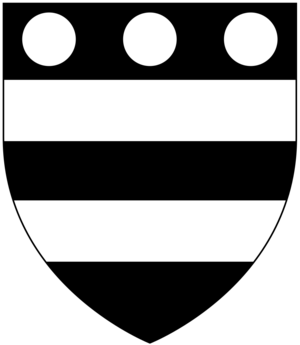Anthony Hungerford of Black Bourton facts for kids
Sir Anthony Hungerford (1567–1627) was an important English gentleman, a Member of Parliament, and a writer. He lived at Black Bourton in Oxfordshire. He also served as a Deputy Lieutenant for Wiltshire until 1624.
Contents
Who Was Sir Anthony Hungerford?
Sir Anthony Hungerford was born in 1567 in Great Bedwyn, Wiltshire. His father, also named Anthony Hungerford, was a Puritan, which was a type of Protestant. However, his mother, Bridget Shelley, was a strong Roman Catholic. Because of his mother's faith, Anthony was raised as a Catholic. His family was connected to the well-known Hungerford family, including Walter Hungerford, 1st Baron Hungerford.
Sir Anthony's Life and Career
When he was 16, in 1583, Anthony Hungerford started studying at St John's College, Oxford. He left without getting a degree at first, but he later earned a Master of Arts degree in 1594.
An important moment in his life happened in 1588. This was when the Spanish Armada threatened England, and there was a lot of tension with Catholic Spain. At this time, Anthony decided to change his religious beliefs. He left his Catholic upbringing and became a Protestant, following the reformed religion.
He was made a knight on February 15, 1608. He served as a Deputy Lieutenant of Wiltshire until 1624. A Deputy Lieutenant was a local official who helped the main Lord-Lieutenant manage the county, especially with military matters. In 1624, he passed this role to his son, Edward.
Sir Anthony was also elected as a Member of Parliament (MP) several times. An MP is someone chosen by the people to represent their area in the country's government.
- In 1593, he was an MP for Marlborough during Queen Elizabeth I's reign.
- He then represented Great Bedwyn in three Parliaments: in 1597, 1601, and the first Parliament of King James I in 1604.
Family Life: Marriages and Children
Sir Anthony Hungerford was married twice.
First Marriage
His first wife was Lucy Hungerford. Together, they had several children, including:
- Sir Edward Hungerford (1596–1648): He was Sir Anthony's oldest son and heir. Edward became a "Roundhead" commander during the English Civil War. Roundheads were supporters of the Parliament against the King.
- Bridget Hungerford: She married three times. Her first husband was Alexander Chocke. Her third husband, John Vaughan, was a Roman Catholic.
Second Marriage
His second wife was Sarah Crouch, from the City of London. They also had several children, including:
- Anthony Hungerford: He was a "Cavalier" during the Civil War. Cavaliers were supporters of the King.
- John Hungerford
- Giles Hungerford
Death and Burial
Sir Anthony Hungerford passed away in late June 1627. He was buried in Black Bourton Church.
His Published Writings
Some of Sir Anthony's writings were published after his death in 1639 by his son Edward. These books shared his thoughts on religion:
- "The advice of a son professing the religion established in the present church of England to his dear mother, a Roman catholic": This book was advice from him, as a Protestant, to his Catholic mother.
- "The memorial of a father to his dear children, containing an acknowledgement of God'? great mercy in bringing him to the profession of the true religion at this present established in the church of England": This writing, finished in April 1627, was for his children. In it, he explained how he came to believe in the Protestant religion.


